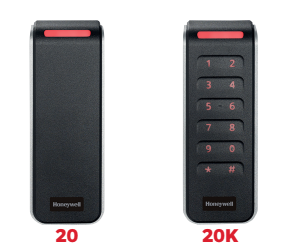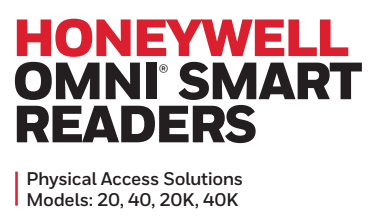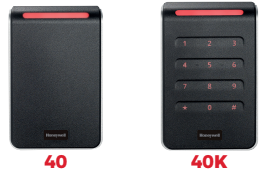SME OFFICES

HONEYWELL OMNI SMART READERS
PRODUCT DESCRIPTION
Omni® Smart is Honeywell’s signature line of physical access control readers. The versatility, performance, and connected capabilities of Honeywell Omni® Smart readers set a new industry benchmark for the most highly adaptable, interoperable, and secure approach to electronic access control.


HONEYWELL OMNI SMART
PRODUCT DESCRIPTION
Omni® Smart is Honeywell’s signature line of physical access control readers. The versatility, performance, and connected capabilities of Honeywell Omni® Smart readers set a new industry benchmark for the most highly adaptable, interoperable, and secure approach to electronic access control.
Offering an unparalleled breadth of functionality, Honeywell Omni® Smart affords security system installers and administrators a simple and effective approach to secure access control for almost any scenario. With support for the widest array of credential technologies — past, present, and future — Honeywell Omni® Smart is the perfect choice for those looking to transition to secure authentication technology.
Honeywell Omni® Smart readers transcend the traditional approach to security by being designed to be connected and managed remotely without needing to physically touch each device. This functionality empowers access control systems to dynamically respond as new needs, configurations, or threats arise.
- Mobile-ready by default
- Sleek, innovative design to suit modern architecture
- Integrated OSDP for secure authentication and configuration post installation
- Built on a hardware platform designed to be adaptable to support future technology
- Leveraging the power of the HID Origo® ecosystem
- Supports Apple’s Enhanced Contactless Polling (ECP) to support credentials in Apple Wallet



Omni® Smart is Honeywell’s signature line of physical access control readers. The versatility, performance, and connected capabilities of Honeywell Omni® Smart readers set a new industry benchmark for the most highly adaptable, interoperable, and secure approach to electronic access control.
Offering an unparalleled breadth of functionality, Honeywell Omni® Smart affords security system installers and administrators a simple and effective approach to secure access control for almost any scenario. With support for the widest array of credential technologies — past, present, and future — Honeywell Omni® Smart is the perfect choice for those looking to transition to secure authentication technology.
Honeywell Omni® Smart readers transcend the traditional approach to security by being designed to be connected and managed remotely without needing to physically touch each device. This functionality empowers access control systems to dynamically respond as new needs, configurations, or threats arise.
MARKET OPPORTUNITIES
- Mobile-ready by default
- Sleek, innovative design to suit modern architecture
- Integrated OSDP for secure authentication and configuration post installation
- Built on a hardware platform designed to be adaptable to support future technology
- Leveraging the power of the HID Origo® ecosystem
- Supports Apple’s Enhanced Contactless Polling (ECP) to support credentials in Apple Wallet
THE SIGNATURE LINE OF READERS FROM HID GLOBAL
- Highly versatile
- Support for the widest range of credential technologies, including HID Mobile Access® via native Bluetooth and Near Field Communication (NFC).

- Unparalleled performance
- Ultra-secure storage of cryptographic keys on certified secure element hardware.
- New surface detection feature that enables the reader to automatically recalibrate and optimize read range performance.

- Connected to the future
- All readers include out-of-the-box support for Open Supervised Device Protocol (OSDP) for secure bidirectional communication.
MANAGE, UPGRADE
AND CONFIGURE
• Leverage HID reader manager for easy set up and management
• Configure via a mobile device or OSDP
• Update firmware in response to threats
• Personalize by configuring audio visual or keypad settings
• Deactivate legacy credential technology to conclude secure migration
POWERFULLY
SECURE
• Multi-Layered security to ensure data authenticity and privacy
• EAL5+ Certified Secure Element Hardware
• Native OSDP secure channel capability
• Trusted secure authentication using the SIO data model
• Supports iCLASS EliteTM and Corporate 1000 Programs
MEET EVERY NEED,
ADAPT TO ANY SITUATION
• Go mobile with native Bluetooth and NFC support
• Integrated 125 kHz credential read support for easy migration
• Supports over 15 common credential technologies
• Flush mount terminal block and pigtail wiring options
• Robust outdoor performance with an IP65 rating
specifications
- Read range listed is statistical mean rounded to nearest centimetre increment for ID-1 or clamshell credentials. HID Global testing occurs in open air. Form factor, technology and environmental conditions, including metallic mounting surface, can degrade read range
performance; plastic spacers are recommended to improve performance on metallic mounting surfaces. - Black trim baseplate and reader spacers available as an additional accessory at an additional cost.
- Measured in accordance with UL294 standards; see Installation Guide for details.
- NSC – Normal Standby Current; see Installation Guide for details.
- Intelligent Power Management (IPM) – Reduces reader current consumption up to 43%, based on model,
compared to standard operating mode.
EASY ORDERING GUIDE All Omni® Smart readers are Mobile Ready
TERMINAL CONNECTION
TERMINAL CONNECTION WITH KEYPAD
COMPATABILITY NOTES

Configuring your reader
1. OS –OMNI® SMART
2. SELECT HARDWARE OPTION (Select one model)

3. SELECT CREDENTIAL PROFILE (Select one option)
4. WIRING CONNECTION
T - Terminal Strip
BODY COLOUR
Black
TRIM/MOUNTING PLATE COLOUR
Silver
Custom Configurations -
(03-Custom Profile) please consult with
your support team for custom configuration options and ordering.
Reader Configuration -
Powered by HID, to configure your readers
utilize the reader manager App available in the Apple or Android store.
Request a Quote
Learn More From
Frequently Asked Questions
Multimode fiber commonly comes in 50/125 μm or 62.5/125 μm core/cladding dimensions, with bandwidth capacities ranging from 200 MHz to 2 GHz, depending on the grade. Multimode systems typically support transmission distances of up to 5 km, making them suitable for short- to medium-range applications.
In contrast, singlemode fiber—usually 9–10/125 μm—offers significantly lower attenuation and effectively unlimited bandwidth, supporting links over 150 to 200 km, especially when paired with optical amplifiers and advanced transceivers.
While singlemode fiber is less expensive per meter, its associated transceivers and equipment tend to cost more than their multimode counterparts. That said, singlemode devices are generally compatible with both singlemode and multimode fiber, whereas multimode equipment works only with multimode fiber.
Let me know if you’d like this turned into a quick-reference table or visual comparison—it’d make a solid inclusion for a fiber deployment guide.
The link budget is the difference between the transmitter’s output power and the receiver’s sensitivity. This budget must account for all signal losses along the path, including:
- Fiber attenuation due to the transmission medium
- Connector losses, such as those at patch panels or equipment interfaces
- Splice losses from mechanical or fusion joints
- Link margin, which provides a buffer for unforeseen variations
The link margin typically ranges from 2–3 dB in tightly controlled environments to up to 10 dB in more variable conditions. It is designed to accommodate:
- Component aging (e.g., light sources may degrade and lose up to 3 dB over time)
- Temperature variations affecting transmitter output or receiver sensitivity (up to 3 dB may be needed for thermal fluctuations)
- Physical cable damage and repair-induced losses (usually minor, but more relevant in harsh or industrial settings)
Always design your system for worst-case scenarios to ensure reliability. However, don’t overlook the best-case condition either—some optical receivers may exhibit erratic behavior if the incoming signal is too strong.
First, verify the optical signal strength along the link. Use an optical power meter to measure the received power at the fiber’s end point. Typical transmit levels range from –8 dBm to –15 dBm, while the receiver sensitivity is around –31 dBm, giving you a link budget of approximately 16 dB. This margin supports transmission distances of up to 10 km on singlemode fiber and about 3–5 km on multimode fiber.
If the measured power falls below the receiver sensitivity, there’s a strong likelihood of issues with the installed fiber. Ideally, initial OTDR readings should have flagged such faults.
If not, inspect the patch cords currently in use for possible defects or misalignment. A frequent oversight is the use of mismatched patch cords.
Multimode fiber types are classified by the ISO/IEC 11801 standard into five main categories: OM1, OM2, OM3, OM4, and OM5. Each type differs in core size, bandwidth, supported data rates, and maximum transmission distances. Here’s a quick breakdown:

- OM3 and OM4 are laser-optimized and widely used in modern data centers.
- OM5 supports shortwave wavelength division multiplexing (SWDM), enabling multiple wavelengths over a single fiber for higher capacity.
- All OM types are backward compatible in terms of connectors, but mixing core sizes (e.g., OM1 with OM3) can cause performance issues.
